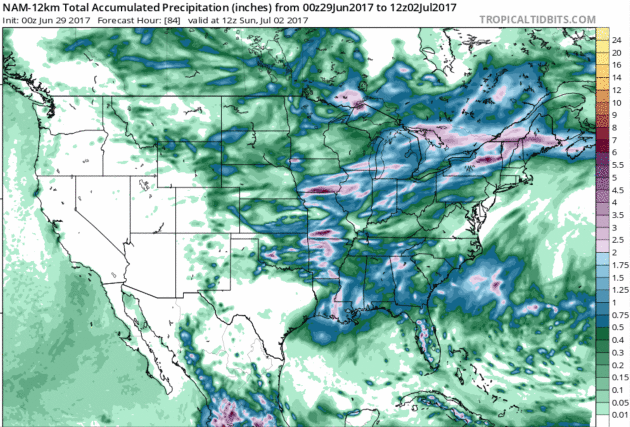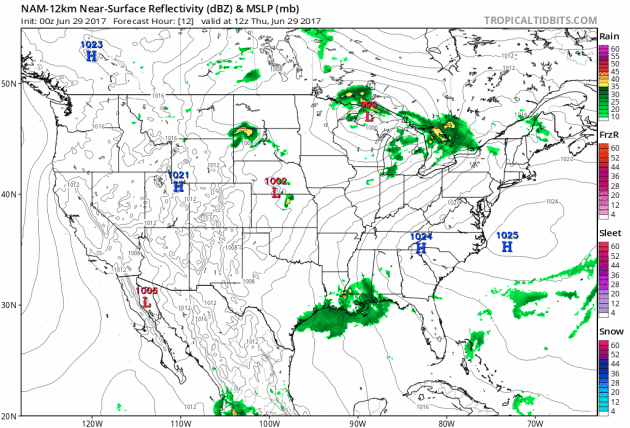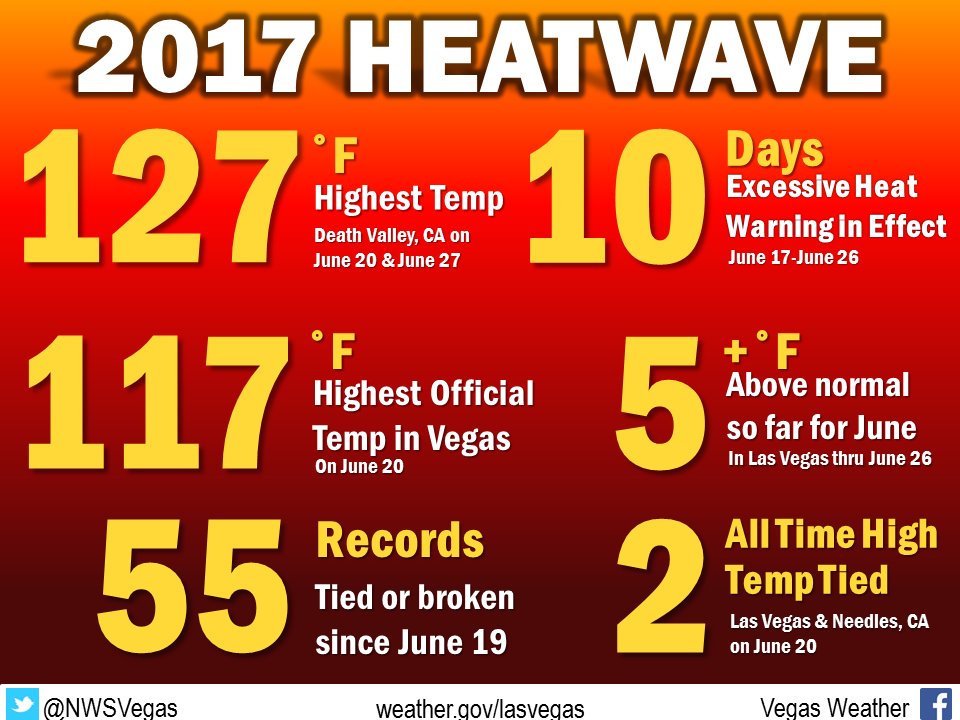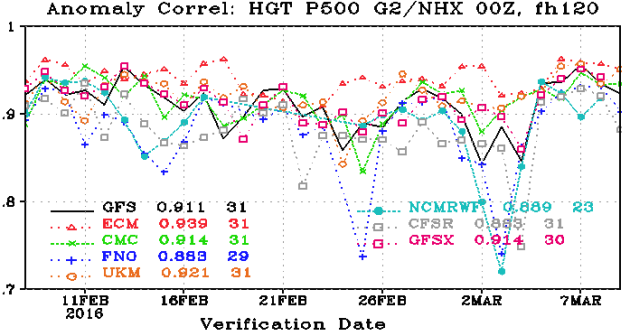June 29, 1969: Worthington picks up over 6 inches of rain in 24 hours.
June 29, 1930: Extreme heat develops in Minnesota. Canby got up to a sizzling 110 degrees.
America’s Original Entrepreneurs – Holiday Preview
The older I get the less I take for granted. Like the food on my plate. It didn’t get there by accident. Farmers are America’s original entrepreneurs, taking huge risks with uncertain returns. All it takes is one hailstorm to wipe out a years worth of hard work. Torrential rains, debilitating drought, scorching heat; not to mention pests and disease risk. I have a lot of respect for the men and women who feed America, and the world.
NOAA’s Climate Extreme Index (above) shows greater volatility, a rising percentage of the nation in severe drought or flood than during the 1960s. Weather whiplash is real, just one more risk factor farmers live with every day.
We get a break from the puddles today with a risk of sunshine and highs nudging 80F, before more showers arrive on Friday.
The holiday weather features a slow warming trend from Saturday into the 4th; most of the T-storms tracking south of the Minnesota River Monday and Tuesday. Low 70s Saturday should give way to 80F on the 4th of July.
Models still bring steamy 80s and even a few 90s into Minnesota by the second week of July.
* Graph above shows CEI, Climate Extreme Index, the percentage of the USA in extreme drought or flood since 1910, courtesy of NOAA NCEI.
Tornado Touchdown in Pierce County, Wisconsin. The cells that blew up right over the MSP metro Wednesday afternoon spun up at least one confirmed tornado near Spring Valley, Wisconsin. KARE-11 reports: “At least one person has been injured and one tornado touchdown has been confirmed in Pierce County, Wisconsin. There were reports Wednesday afternoon of a number of trees and power lines down in the area, along with significant damage to homes. Kevin Knutson tells KARE 11 that Knutson Family Farms lost two barns — one in Martell and one in Gilman Township...” (Photo: Sky 11).
Let’s give credit where credit is due. This was the severe storm outlook for Wednesday from NOAA SPC:
Here is where severe weather was actually reported. Tornadoes or funnel cloud sightings are in red, large, damaging hail is represented by blue dots, straight-line wind damage shows up as yellow markers:
Wednesday Severe Storm Reports. An intense squall line sparked 1-2 dozen tornado reports, clustered from Iowa into southeastern Minnesota and Wisconsin yesterday. Map courtesy of NOAA SPC and AerisWeather.
Thursday Severe Weather Threat. Another volatile day is brewing, especially for the central Plains, where a few (large) tornadoes can’t be ruled out later today. An enhanced risk includes Omaha, Lincoln and Topeka, as well as Council Bluffs, Iowa. But an elevated severe risk extends into Chicago, Detroit, Toledo and Cleveland. Stay alert, there will be watches and warnings issued.
Flash Flood Potential. A few waves of strong to severe thunderstorms tracking over the same waterlogged counties may result in 2-3″ amounts falling over the next 24 hours, especially Kansas City and Omaha to Des Moines, Rockford and Chicago.

84-Hour Rainfall. Once again the western third of the nation looks bone-dry into Sunday morning, but the pattern is ripe for heavy rainfall, especially Mississippi River Valley and the Midwest into northern New England, where some 2-5″ rainfall totals are possible over the next 3-4 days. Map: Tropicaltidbits.com.

Future Radar. The area to watch today is the central Plains and Midwest; more severe storms blowing up along a nearly stationary front, sparking wind damage potential and large hail from Omaha and Des Moines to Chicago. More rain is likely for the Gulf Coast and Mid South, with showers and thundershowers overspreading New England by tonight. NAM guidance: NOAA and Tropicaltidbits.com.
Hot Days Brewing. Irritated by the relatively comfortable spell of weather we’ve experienced lately? You’ll get your wish: ECMWF guidance shows consistent 80s, starting on the 4th of July, spilling into at least mid-July with a few days approaching 90 degrees. Factor in a dew point in the 60s and you’ll have all the Dog Day weather you can handle. Twin Cities meteogram: WeatherBell.
4th of July Heat Index. 110F in Corpus Christi, Tallahassee and Savannah by next Tuesday? Serious heat continues to bake the deep south, with a heat index approaching 100F as far north as Memphis and Washington D.C. on our nation’s birthday. Some of this heat will spread north in the coming weeks, giving all of us a chance to whine about the humidity. Map credit: NOAA NCEP.
Prime Time Summertime. The 2 week outlook for 500mb winds shows a persistent heat wave stretching from southern California into the Plains and even New England. The northern Rockies may get a break, but by mid-July much of the USA will be sweltering. Pretty typical for this time of year.

A Steamy June, Nationwide. Here’s an excerpt from Planalytics: “June 2016 was one of the warmest on record in the U.S. Across most eastern markets, it was also the driest June in five years or more. This boosted overall traffic levels and sales of summer products. This June’s cooler and rainier conditions (compared to 2016) will negatively impact comp sales performance for many retailers and restaurants. The less favorable weather is projected to cost restaurants $447 million in sales vs. June 2016. Apparel chains face a $106 million headwind...”
IBM Just Threw Its Hat Into the Weather Modeling Ring. Could a private business (in this case IBM) come up with a weather model that consistently out-performs NOAA, even the European Center’s ECMWF? It may be inevitable. Here’s an excerpt of a post from Angela Fritz at Capital Weather Gang: “Computing giant IBM is getting into the weather modeling business. After buying the Weather Company — a.k.a. the Weather Channel — in 2016, it was only a matter of time before IBM combined supercomputers and weather forecasting. Specifically, IBM and the Weather Company are collaborating with the National Center for Atmospheric Research to implement the MPAS model, or Model for Prediction Across Scales, on IBM’s new generation of supercomputers. The MPAS has been available for research and forecasting since 2013. What makes this announcement a little more interesting the National Weather Service had the opportunity to use this model to replace the GFS, though NCAR pulled out of the selection process in the final hours. The selection committee ended up choosing a different model in July of last year — a decision one expert said was “a disaster for U.S. weather prediction…”

Did NOAA Make the Right Choice for It’s Revamped Global Weather Model? I’m sharing a post from a meteorologist I trust and respect, Cliff Mass, at the University of Washington – dating back to March of 2016. Dr. Mass makes the case for going with NCAR’s MPAS weather model. Ultimately NOAA decided on GFDL’s FV3 model, for a variety of reasons. IBM just teamed with UCAR to commercialize the MPAS simulation on a global scale, their “GPU” approach allowing much finer resolution. Consider this good background information, and although it delves into the weeds explaining the physics involved, this helps to explain why IBM is going in a different direction: “…The National Weather Service admits the GFS needs to be replaced. During the past year or so, the National Weather Service, using money provided by Congress after the relatively poor Hurricane Sandy forecast, has sponsored a model “bake off” between potential replacements. The project, called NGGPS, the Next Generation Global Prediction System, has now narrowed down the selection to two possible models (also known as dynamic cores). And the differences between these candidates could not be more stark. The first, MPAS, Model Prediction Across Scales, was developed by the main national research center of the atmospheric community, NCAR (the National Center for Atmospheric Research). It is an innovative model that can accurately predict weather on all scales, allows variations in resolution to produce finer resolution where needed, and is very efficient in using computer resources...”
Image credit: “The latest verification, in this case the global 5-day forecasts at 500 hPa, shows the European Center (red triangles) to be consistently superior than the U.S. GFS (black line).”
UCAR Collaboration With the Weather Company to Improve Weather Forecasts Worldwide. Here’s more information on how UCAR is teaming with IBM to try and improve the state of the art when it comes to weather modeling: ” The University Corporation for Atmospheric Research (UCAR) today announced a new collaboration with The Weather Company, an IBM business, to improve global weather forecasting. The partnership brings together cutting-edge computer modeling developed at the National Center for Atmospheric Research (NCAR) with The Weather Company’s meteorological science and IBM’s advanced compute equipment. “This is a major public-private partnership that will advance weather prediction and generate significant benefits for businesses making critical decisions based on weather forecasts,” said UCAR President Antonio J. Busalacchi. “We are gratified that taxpayer investments in the development of weather models are now helping U.S. industries compete in the global marketplace…”
Image credit: “The Model for Prediction Across Scales (MPAS) enables forecasters to combine a global view of the atmosphere with a higher-resolution view of a particular region, such as North America.” UCAR.
A New Supercomputer-Powered Weather Model May Be Ready for Exascale. Here are a couple of excerpts from a post by Jim Sexton at IBM: “In the U.S. alone, extreme weather caused some 297 deaths and $53.5 billion in economic damage in 2016. Globally, natural disasters caused $175 billion in damage. It’s essential for governments, business and people to receive advance warning of wild weather in order to minimize its impact, yet today the information we get is limited. Current global weather forecast models can predict weather patterns down to regional-scale weather events, such as snowstorms and hurricanes, but lack the ability to predict more local phenomena such as thunderstorms…That’s why IBM Research, The Weather Company, the University Corporation for Atmospheric Research (UCAR) and the National Center for Atmospheric Research (NCAR) are collaborating to develop the first rapidly-updating, storm-scale model that can help predict weather events such as thunderstorms at local scales…”
Image credit: “IBM Research, The Weather Company and NCAR aim to use supercomputing to enable short-term thunderstorm forecasts as well as more accurate long-range forecasts days, weeks and months in advance.” (Credit: Shutterstock).
What is a “Radar Hole” and Why Should I Care? An article at West Virginia’s Exponent Telegram reminded me that NWS Doppler, as good as it is, has limitations, and some counties can fall between the cracks of where these Doppler radar systems operate: “…One other issue brought into focus by Friday’s storm was the presence of radar holes, or areas that radar struggles to capture accurately due to distance from the radar station itself. Due to the fact that, as Casey said, the radar pulse has to travel over the earth’s curvature, it gains height as it goes farther — thus meaning that those areas far from the signal’s initiation will have potentially inaccurate readings. Casey said that because the three radars that serve West Virginia are in Charleston, Pittsburgh and Sterling, Virginia (near Washington, D.C.), much of the North Central West Virginia area falls under such a “hole”...”
The Southwest is Burning. Check out the trends, according to High Country News and Grist: “…Nationally, wildfires have consumed more than 2.5 million acres of land so far this year. In the past decade, more acreage burned by this point only once, in 2011. That year, unusually hot, dry conditions led to several large conflagrations, including New Mexico’s Las Conchas Fire and Arizona’s Wallow Fire...”
Graphic credit: “The line traces the fire acreage; the labels show the number of fires per year.” Keith Halloran/U.S. Forest Service.
Lightning-Caused Fires On The Rise in the World’s Largest Forest. National Geographic reviews new research: “As fire season reaches for its annual summer turning point, the role lightning plays as the culprit in setting fires shows a worrisome trend. That’s not good news for the boreal forest, the world’s largest forest habitat, where virtually all wildfires are ignited by lightning. Since 1975, the number of fires ignited by lightning has increased between two and five percent, driven by an increase in volatile thunderstorm weather, according to a new NASA study published Monday in Nature Climate Change. In two of the last three years, immense fires in Alaska and Canada’s Northwest Territories provided a good case study, says Sander Veraverbeke, the study’s lead author and an Earth scientist at Vrije Universiteit Amsterdam...”
Photo credit: “This forest fire was caused by lightning, and the problem seems to be on the rise since 1975.” Photo by Mark Thiessen, National Geographic Creative.
Frequency of Billion Dollar U.S. Weather and Climate Disasters. Here’s an excerpt from NOAA NCEI: “…NCEI is the Nation’s scorekeeper in terms of addressing severe weather and climate events in their historical perspective. As part of our responsibility to monitor and assess the climate, we maintain a record of the weather and climate events that have had the greatest economic impact from 1980 to 2017. The United States has sustained 208 weather and climate disasters since 1980 where overall damages reached or exceeded $1 billion (including CPI adjustment to 2017). The total cost of these 208 events exceeds $1.1 trillion...”
Graphic credit: NOAA NCEI: “Event statistics are added according to the date on which they ended. Statistics valid as of April 6, 2017.”
A Million Bottles a Minute: World’s Plastic Binge “As Dangerous as Climate Change”. Not sure I agree with the comparison, but there’s little question the threat is real, especially to the world’s oceans. Here is a clip from The Guardian: “A million plastic bottles are bought around the world every minute and the number will jump another 20% by 2021, creating an environmental crisis some campaigners predict will be as serious as climate change. New figures obtained by the Guardian reveal the surge in usage of plastic bottles, more than half a trillion of which will be sold annually by the end of the decade. The demand, equivalent to about 20,000 bottles being bought every second, is driven by an apparently insatiable desire for bottled water and the spread of a western, urbanised “on the go” culture to China and the Asia Pacific region…”
Photo credit: “A file picture dated 13 April 2010 shows a boy from Senegal walking along a polluted beach strewn with predominantly plastic bottles in the village of Ngor, Dakar, Senegal.” Photograph: Nic Bothma/EPA.
“Bring on More Renewables,” U.S. Regulator Says as Grid Study Looms. Reuters explains that the grid can, in fact, leverage more clean renewables without sacrificing reliability and stability: “Wind and solar power does not make the U.S. electricity grid less stable, an outgoing federal regulator said on Tuesday, as the Trump administration readies a study that will examine whether renewable energy has had a harmful effect. Colette Honorable, a member of the Federal Energy Regulatory Commission, said at a conference that renewables have different attributes than base load power, which includes coal and nuclear energy, and that those difference need to be overcome. But Honorable stressed that record amounts of wind and solar power had been generated recently without harming the grid…”
EPA Chief Met With Dow CEO Before Deciding on Pesticide Ban. Associated Press reports: “…EPA released a copy of Pruitt’s March meeting schedule earlier this month following several Freedom of Information Act requests. Though his schedule for the intervening months has not yet been released, Bowman said Pruitt has had no other meetings with the Dow CEO. There was a larger group meeting that Pruitt attended which also included two other Dow executives, but she said that didn’t involve chlorpyrifos. Dow, which spent more than $13.6 million on lobbying in 2016, has long wielded substantial political power in the nation’s capital…”
UPS Looks To Add More Green Vehicles To Its Fleet by 2025. Reuters has details: “United Parcel Service Inc said on Tuesday it would add more vehicles that run on non-conventional power to its fleet by 2025, as the package delivery company looks to cut its greenhouse emissions. The company said by 2020 about 25 percent of its vehicles purchased annually will be powered by alternative fuels or advanced technology, up from 16 percent in 2016. The vehicles could include electric, hybrid electric, hydraulic hybrid, or those that run on compressed natural gas, liquefied natural gas, and propane…”
Photo credit: “A United Parcel Service (UPS) truck on delivery is pictured in downtown Los Angeles, California October 29, 2014.” REUTERS/Mike Blake.
Electric Vehicles: Good for Public Health and the Planet. Fresh Energy explains: “…Electric vehicles present a tremendous opportunity for carbon reduction. A recent study by Dane McFarlane of the Great Plains Institute compared the total lifecycle carbon emissions of gasoline and electric vehicles in Minnesota. The results were striking: for the average Minnesotan, switching to an electric vehicle reduces carbon emissions by over 50 percent. And if the electric car is powered by Xcel Energy—the nation leader in wind generation—carbon emissions fall by two-thirds. Further, an electric vehicle powered by renewable energy reduces carbon emissions by 95 percent! Electric vehicles are not just cleaner today, their emissions actually go down over time as electricity generation becomes cleaner. Coal plants are being retired at a breakneck pace. Since 2010, nearly half of the nation’s coal plants have either been retired or have announced a retirement date…”
Accelerating Electric Vehicles in Minnesota. Here’s a clip from a post at The Center for Energy and Environment: “…Getting to the nitty gritty, our team dug deep to determine current barriers to electric vehicle penetration and how we might begin to overcome those barriers. For one, Minnesotans don’t have access to all of the electric vehicle models that are available in states like California, where zero emission vehicle policies drive high-penetration and create concentrated value propositions for manufacturers and auto dealers. Additionally, our charging infrastructure is relatively nascent, which may be a barrier to building consumer confidence. Increasing electric vehicle visibility and making purchasing simple — especially for first-time buyers — will stimulate the marketplace. With this in mind, our team identified scalability and awareness as key priorities to overcoming the barriers electric vehicles face in Minnesota…”
Is Clean Energy the “Ultimate Weapon” Against Russian Security Threats? Here’s an excerpt of an interesting post at Greentech Media, written by Jonathan Morgenstein, a Marine Corps veteran and solar executive, lays out how renewables can render Putin powerless: “…In January, Secretary of Defense Jim Mattis called Russia the “principal threat” to America today. But despite Russia’s might, there’s a glaring chink in its otherwise impenetrable armor: an extraordinary dependence on its sale of fossil fuels. Over the past decade, the U.S. has developed the ultimate weapon — clean energy — to protect us from and neutralize the multi-tentacled Russian threat. The U.S. clean energy industry, in partnership with the U.S. government, has the opportunity over the coming decades to earn billions while strengthening our national security. Together they can assist Europe in overhauling energy infrastructure and starving Moscow’s budget of its essential fossil fuel revenue, rendering Putin powerless...”
After 9 Launches in 2017, It’s Tough To Be an Honest Critic of SpaceX. I might hesitate before betting against Elon Musk anytime soon. Here’s an excerpt from Ars Technica: “Elon Musk and SpaceX had one hell of a weekend. While much of the country celebrated the summer weekend at the beach or enjoying time with friends, SpaceX was hard at work launching two rockets for customers, one from the East Coast and one from the West Coast. One of those rockets had previously been flown. And despite dangerous returns due to high-energy missions and inclement weather, the company recovered both of the first stage boosters. SpaceX garners a lot of acclaim for its achievements, and it has legions of admirers within the aerospace community and the public at large. But it also has critics, primarily competitors who look at SpaceX and see a company that gets a lot of hype but doesn’t always deliver. What is perhaps most striking about this weekend’s back-to-back launches is that the company’s successes drove a stake into some of the most credible criticisms that have been levied against SpaceX in recent years...”
Image credit: SpaceX.
$100 Million/Year Back Pain Industry is Mostly a Hoax. So says the author of a story at Quartz: “…Millions such bad decisions, she argues, have fueled a $100-billion-per-year back pain industry in the US—one that’s largely selling Americans wrong and even dangerous responses to back discomfort. These include unnecessary painkillers, injections, surgeries, and chiropractic “adjustments.” About 80% of Americans are expected to suffer from at least one episode of lower back pain in their lifetime, and millions with chronic pain are already lost in the industry, subjected to pseudo-interventions, or taking unnecessary and addictive opioids like Vicodin or Oxycontin, then doubling down on the drugs as their tolerance and the pain escalates. (In some cases, the increased pain is actually caused by the opioids.)...”
The Death of Local Small Market TV News. There’s a more cost-effective way to deliver local news, but do you lose local institution memory and perspective when the anchors delivering the news are 1,000 miles away? Here’s a clip from a story at FTVLive: “…Media Gateway specializes in that sort of outsourcing, offering to save TV stations two-thirds of the usual cost for some functions. For a monthly fee it will, as its website puts it, “take over the headache of television master control and playout through our central facility.” Hubbing, as the centralized approach is known, is a future that has already arrived, Davidge told Arkansas Business. “In 10 years, all of the small-market stations will be doing it that way,” he said. “The large-market stations may beat their chests and say look at how many anchors and rooms of computers we have.” But for smaller markets grappling with shrinking margins as viewers turn away from traditional TV habits, “this makes a great deal of business sense...”
In 10 Years, Your iPhone Won’t Be a Phone Anymore. Transparent and seamless, no need to look down and check your “phone”? The Wall Street Journal (subscription) explains: “It’s 2027, and you’re walking down the street, confident you’ll arrive at your destination even though you don’t know where it is. You may not even remember why your device is telling you to go there. There’s a voice in your ear giving you turn-by-turn directions and, in between, prepping you for this meeting. Oh, right, you’re supposed to be interviewing a dog whisperer for your pet-psychiatry business. You arrive at the coffee shop, look around quizzically, and a woman you don’t recognize approaches. A display only you can see highlights her face and prints her name next to it in crisp block lettering, Terminator-style. Afterward, you’ll get an automatically generated transcript of everything the two of you said...”
Illustration credit: Daniel Hertzberg.
TODAY: Partly sunny, dry. Winds: NW 5-10. High: 81
THURSDAY NIGHT: Clouds increase, showers late. Low: 63
FRIDAY: Soggy skies – more showers likely. Winds: NW 5-10. High: 72
SATURDAY: Some sun, isolated shower risk. Winds: NW 7-12. Wake-up: 60. High: 74
SUNDAY: Mix of clouds and sun, warmer. Winds: S 7-12. Wake-up: 61. High: near 80
MONDAY: Lukewarm sun north, storms far south. Winds: NE 5-10. Wake-up: 62. High: 81
4TH OF JULY: Sticky with periods of sunshine. Winds: NE 8-13. Wake-up: 64. High: 82
WEDNESDAY: Plenty of sun, noticeable humidity. Winds: SE 8-13. Wake-up: 66. High: 83
* Models are hinting at upper 80s by the end of next week.
Climate Stories…

Make Climate Change Bipartisan Again. As recently as 2007 there was little disagreement between Republicans and Democrats about the threat (and opportunity) posed by rapid, man-made climate change. But today the science has been swept up into a partisan political food-fight, argues an Op-Ed at The Tennessean: “…An approach that can find common ground between Republicans and Democrats is “carbon fee and dividend,” whereby a steadily rising fee is placed on fossil fuels, with the revenue returned to consumers. The fee sends a powerful price signal to the marketplace to speed up the transition to a clean-energy economy. Returning revenue to households will shield families from the impact of rising energy costs associated with the fee. To protect American businesses, a border adjustment tariff would be applied to imports from nations that do not have an equivalent price on carbon, providing a strong incentive for countries to follow our lead with a similar policy. Regional Economic Models found that, after 20 years, carbon fee and dividend would reduce emissions 50 percent while adding 2.8 million jobs to the economy…”
File image: TechCrunch.
A Huge Part of Antarctica is Melting, and Scientists Say That’s Bad News. Unusually warm water is melting ice near the coast, which may accelerate ice flows into the oceans, accelerating sea level rise. CNN.com explains: “Antarctica is experiencing weird weather, and the changes have some scientists worried about the future. There’s an area on the west side of the icy continent called the West Antarctic Ice Sheet, and last January, scientists found a 300,000-square-mile portion of its perimeter was melting. That’s an area roughly two times the size of California, covered in slush. According to recent research published in Nature Communications, the melt was caused by an unusually strong El Niño event around January 2016…”
Climate Change is an Energy Problem, So Let’s Talk Honestly About Nuclear. Until we can get clean, renewable energy at scale, we still need nuclear to provide a carbon-free source of energy. An Op-Ed at The Guardian has food for thought: “…Clearly then, we urgently need a nuanced discussion on our energy future to stave off the worst ravages of climate change. Yet too often this falls at the first hurdle; with old battle-lines long drawn, nuclear advocates and opponents hold their own courts, talking only to their own side and dismissing the criticism and concerns of the other. These echo chambers may be comforting, but they are ultimately detrimental to our collective wellbeing. With the chaos of climate change on our doorstep, it has never been more imperative that we make informed decisions about how best to power our world. For progress to occur, both sides need to heed each other and have an honest conversation about the advantages and risks of all forms of energy production…” (File image: Shutterstock).

The Fact Is: Facts Don’t Matter to Climate Deniers. We tend to filter out facts that may cause conflict with our friends or larger world-view, argues Eric Holthaus at Grist: “…Scientists have spent more than 30 years now trying to provide as much information in as many ways as possible and, if anything, climate denial is only getting more entrenched. What will it take for scientists to realize that this denial is a choice? Decades of communications and psychology research shows that appeals to shared goals, values, and basic decency are a more effective way of working with conservatives on climate change. In red states across the country, renewable energy is booming, and it’s not because people there necessarily “believe” in climate change. It’s because renewable energy provides solutions that make sense. Scientists and liberal politicians need to move beyond trying to convince skeptics, and start working with them. There’s no time to lose...”
Phoenix Heat, Tropical Storm Cindy Show How Climate Change is a Threat To Our Infrastructure. Details via an Op-Ed at The Washington Post: “Much of the Southwestern United States is reeling under a heat wave so severe that it has forced airlines to ground flights. On the Gulf Coast, millions of people were put on emergency alert ahead of Tropical Storm Cindy, which caused widespread flooding and power outages. Climate change is already affecting our economy and safety, with risks to critical infrastructure — roads, bridges, dams, water and energy infrastructure and military sites. The nation’s infrastructure is already in a precarious state, consistently earning a near-failing grade of D-plus from the American Society of Civil Engineers. Much of it was built assuming past climate and weather patterns, with some margin of safety. But now, climate change — in the form of more frequent and severe heat waves; floods exacerbated by sea-level rise and increased heavy rainfall; droughts; wildfires; and other impacts — is adding an extra layer of risk...”
Photo credit: “Planes sit on the tarmac at Phoenix Sky Harbor International Airport. American Airlines says seven regional flights have been delayed and 43 have been canceled because of a heat wave as temperatures climb to near-record highs on Tuesday.” (Ross D. Franklin/Associated Press).
Will Climate Change Make Severe Weather Like the Recent Hailstorms the Norm in Colorado? The data is still inconclusive, but it’s worth watching the trends, according to a post at Colorado Public Radio: “The hailstorm that struck the Denver metro area last month was the costliest natural catastrophe in state history, with more than $1 billion in losses, according to the Rocky Mountain Insurance Information Association. That’s not the only recent example of severe weather in Colorado, what with record-setting heat being recorded in the last couple of weeks. Is this becoming the norm, and how much of it might be attributed to climate change? From wildfires to changes to the state’s national parks, all around us there are examples of how an evolving environment is impacting life here. Those changes can been seen throughout the calendar, from the vineyards that yield summer wines, to the winter ski season...”
Photo credit: “Patrick Clark inspects his damaged car after a strong spring storm moved through the metropolitan Denver area Monday afternoon, May 8, 2017.” AP Photo – P. Solomon Banda.
Baseball Size Hail Trends in Minnesota. Dr. Mark Seeley shared this slide with me recently, showing an apparent increase in the frequency of baseball-size hail (2.75″ diameter) across the state. As is always the case nature never moves in a perfectly straight line, but step back and look at the trends.
Bigger Hail Might Pummel the U.S. as Climate Change Gathers More Force. The Verge has more perspective on the dynamics in play: “…A study published today in Nature Climate Change shows that in the second half of this century, North America could experience fewer hail days overall, but storms with larger hail might become more common, including hail that’s larger than 1.6 inches — exactly like the hailstorm that plummeted Denver. This is bad news across the board: hail can destroy crops, as well as homes and cars, leading to more insurance losses. Predicting how hail will change due to global warming is very complicated. Hail forms during thunderstorms, when fast air currents carry water droplets up in the sky, where they freeze into hailstones. As more water freezes around them, these lumps of ice become too heavy and fall onto the ground as hail...”
Photo credit: “
Antarctic Sea Ice Levels Have Shrunk to Record Low Levels for Late June. Jason Samenow reports at Capital Weather Gang: “The late June sea ice surrounding the Antarctic continent is at its lowest level in nearly 40 years of records, according to data from the National Snow and Ice Data Center. While it is currently the start of winter at the South Pole and sea ice extent is expanding, current levels show the extent is right around 13.1 million square kilometers, far below the average extent at this time of year around 14 million square kilometers. Antarctic sea ice extent has been monitored since 1979…”
Map credit: “Antarctic sea ice concentration relative to 1981-2000 normal, June 25, 2017.” (National Snow and Ice Data Center).
Global Sea Level Rise Accelerates Since 1990, Study Shows. This will become non-trivial for anyone living on or near the coast, according to a story at Reuters: “The rise in global sea levels has accelerated since the 1990s amid rising temperatures, with a thaw of Greenland’s ice sheet pouring ever more water into the oceans, scientists said on Monday. The annual rate of sea level rise increased to 3.3 millimeters (0.13 inch) in 2014 – a rate of 33 centimeters (13 inches) if kept unchanged for a century – from 2.2 mm in 1993, according to a team of scientists in China, Australia and the United States. Sea levels have risen by about 20 cms in the past century and many scientific studies project a steady acceleration this century as man-made global warming melts more ice on land...”
File image: Skeptical Science.
How Climate Change Will Transform the Way We Live. Fortune has a summary of new research into the implications of consistently hotter summers: “…According to a study co-authored by Mora, if carbon emissions aren’t reduced, by 2100 New York City will experience about 50 days per year of heat and humidity conditions that has resulted in death (up from about two days now). Meanwhile, in cities such as Orlando and Houston, this threshold will be crossed for the entire summer, making it unsafe to go outside for extended periods of time. “We’ll become prisoners of our houses,” says Mora. In this brutally hot version of the future, in many U.S. cities air conditioning will become a literal life saver. Power outages, like the one that swept through Northeast and the Midwest in 2003 — leaving 50 million people without electricity—will no longer be an inconvenience, but a national emergency…”
Wall Street Is Starting to Care About Climate Change. As always, follow the money. Here’s an excerpt from Axios: “A record number of investors are pressuring fossil-fuel companies to reveal how climate change could hit their bottom lines. Efforts by shareholders to push resolutions on the risk related to carbon regulations are reaching a tipping point, with almost half of investors in fossil-fuel and utility companies backing resolutions, according to a new analysis by nonprofit group Ceres not yet published publicly. Activist shareholders of publicly traded companies have been pushing resolutions on climate change for years and now the effort is going mainstream with new support from institutional investors...”
Illustration credit: Rebecca Zisser / Axios.
Image credit: Google.

